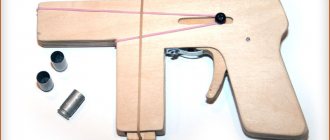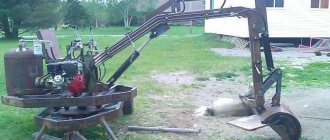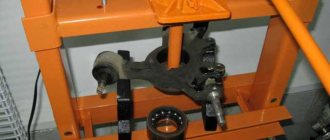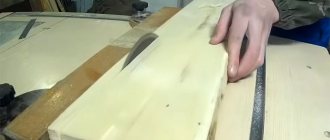Which can be an excellent toy for developing mechanics in children. So, we will make an excavator from syringes.
We will need: - 5 syringes per 20 cubic meters; — 5 syringes for 5 cubes; — plastic clamps; — nuts, washers and bolts with a diameter of 4 mm; - wooden rulers; — rail 30x10 cm; — drip system.
The first step is to make an arrow from a batten. Below we present the drawings and markings.
You need to make the second half of the arrow from two rulers. We connect the halves of the boom with a bolt, washers and a nut. We place a piece of lath between the rulers to give the arrow its shape.
Cut the ruler lengthwise and make two holes along the edges.
We also glue a piece of slats between the resulting pieces.
We also make an excavator tower from slats.
We connect two tower blanks to the boom.
A 2 cm thick board will serve as a frame, so we cut out a round blank on which the arrow will be attached.
We make grooves on the round blank according to the size of the tower blanks. The tower can also be connected using iron corners. If you have made cuts, you can additionally glue the tower with hot glue. We glue a piece of lath between the two elements of the tower so as not to pinch the arrow when tightening it.
We glue the cuttings of the ruler to give the required thickness.
The base can be made from a piece of board 3 cm thick. Drill a hole on the base and insert a bolt. Let's move on to making the ladle. The blanks are shown in the photo below.
We assemble the ladle with a glue gun.
We make a groove in the boom rail in which a small syringe can be attached. We fix the syringe with a plastic clamp.
We connect the boom to the bucket using a wire, which should connect the ruler of the bucket to the clamp. We connect the remaining moving places in the same way. According to the author, the places where the clamps are tightened must be wrapped with a thick layer of electrical tape so as not to bend the syringe. Also, do not tighten the clamps too tightly. The load on the syringe can be reduced by attaching a rubber band for banknotes.
Frequent rental of earth-moving equipment is a costly procedure and does not provide convenience to the owner of the site. Another thing is your own compact car, with which you can save on rental services, consume a minimum of fuel and at the same time get all the functions of full-fledged models. It is not easy to create such a technique, but for a true master it is not impossible. How to make a mini excavator with your own hands? First you need to determine its parameters and type.
A properly assembled mini-excavator is in no way inferior to models created according to all the rules in the factory. It has some advantages for private use: minimal fuel consumption, easy transportation, adaptability to specific needs, low weight. You can work in any area, including warehouses and other enclosed spaces. Typically, such equipment is required at dachas, near country houses, used in digging holes and ditches, for shallow communications, etc.
There are different types of mini excavators
Types of homemade models:
- An excavator made from a walk-behind tractor, based on an existing mini tractor or just a car. It uses attachments. Autonomous vehicles are assembled on tracked or wheeled vehicles, capable of moving around the site independently. Another option is a machine that can be moved using aids. If necessary, all attachments can be easily dismantled, and the used base can be used again for its intended purpose.
- Mini excavator from scratch. A labor-intensive option for the most experienced craftsmen. It is impossible for a beginner to cope with such a task; time and money will be wasted. You will need specific skills or qualified assistants, a good amount of technical knowledge.
- A simple budget solution is a trailed excavator on a T40 trailer with a frame and a wheel axle.
An autonomous engine, hydraulics and specific equipment are installed.
Preparatory stage: where to get the drawing
You need to choose a specific, clear and understandable diagram for assembling your earthmoving machine.
There should not be any difficulties with the choice. Can be used:
- Reduced to scale factory diagrams of large Belarus-type excavators.
- Ready-made drawings from the Internet, posted by folk craftsmen. Interesting working options can be found not only in RuNet, but also on foreign resources.
Having selected the optimal drawing, you need to draw up an estimate and roughly determine the costs of consumables and parts.
Where to get drawings
The next step when creating a homemade mini excavator is to select a specific model diagram that includes all the necessary elements and standard sizes of individual parts and mechanisms. In this case, you can develop your own design, if you have the appropriate technical knowledge and skills for this, calculating the required engine power, hydraulic pump and forces on the hydraulic cylinders, taking into account the nature of the future work performed.
You can also use a ready-made scheme developed by other craftsmen. Ready-made drawings of various models of mini excavators and instructions for their manufacture can be found on many Russian and foreign sites on the Internet by entering the query “homemade mini excavator drawing” in the search bar of your browser. However, one should take into account the fact that in most drawings presented on foreign sites, dimensions are indicated in inches. Therefore, for the convenience of further work, it is necessary to convert them to the metric system of measurements.
Having a specific diagram (drawing) in hand, it is necessary to make an approximate estimate for the purchase of the necessary spare parts and materials, as well as the availability of the necessary tools, equipment and skills in handling them. Thus, you can finally determine your capabilities and prospects for independently manufacturing a mini excavator.
Constructive decisions
A homemade manual excavator is configured in the same way as factory car models. This technique contains the following nodes:
- A supporting frame mounted on tractor tracks or vehicle tracks.
- ICE for driving hydraulics.
- Rotating support part.
- Hydraulics.
- Ladle.
- Arrow.
Choosing a bucket for an excavator
The optimal solution would be to install equipment on the T40 or create a similar trailer with your own hands to install a motor, tank, and wheelset on it. The stability of the machine will be ensured by additional shoe fastening: a pair of “shoes” will keep it from tipping over.
The motor can be an internal combustion engine with a power of 15 kW - a Japanese or even an inexpensive Chinese model.
Mini excavator components
The boom and hydraulic system can be purchased as a kit and simply installed on the base. Such a solution will eliminate many mistakes and search for spare parts. For the entire period of operation, you can forget about setting up the earthmoving machine. But such kits are expensive, and with the proper experience, home craftsmen prefer to make all the components with their own hands. Modernized components from old equipment can also be used.
Hydraulic system
In factory excavators, the hydraulic system consists of 4 parts:
- slewing support;
- arrow;
- ladle;
- control system.
When making an earthmoving machine with your own hands, you can resort to a simplified version. In this case, you will need a slewing ring and a boom. The column is mounted on a supporting structure, the role of which can be played by a walk-behind tractor. To make the units yourself, you need to have 4 hydraulic cylinders for moving the boom down and up, controlling the bucket, and turning. Old hydraulic cylinders from Soviet-made trucks will do.
For hydraulic drive it is convenient to use an inexpensive gear pump. This is an easy to use and repair, budget solution. Most often, craftsmen choose NSh-10, combining it with the R-16A distributor.
If necessary, increasing the power of the equipment is achieved by simultaneously installing 2 pumps with 2 distribution units.
Technology at work
How to make a ladle
The working part of the machine is a bucket. This part is subjected to maximum loads, which is why increased demands are placed on the quality of the material. The optimal solution is sheet steel 6-9 mm thick.
Separate blanks are calculated according to the drawings and cut from a steel sheet, and securely welded together. To strengthen the sides and bottom, additional steel plates are used. The efficiency and productivity of the bucket will increase if durable “fangs” are welded on the front. The “fingers” of tracked vehicles can be used for them.
At all times, tools and equipment that combined different functionality were quite popular. A similar trend also applies to equipment that is commonly used in one’s suburban area. On the market for relevant products you can find mini-tractors and walk-behind tractors. Each model has different attachments. All this allows you to carry out municipal and agricultural work. Manufacturers of attachments miss one important operation, which is required from time to time in the process of housekeeping. This includes all kinds of earthworks. It is quite difficult to find additional attachments for tractors and walk-behind tractors on the market that would help with excavation work. Of course, you can purchase a mini excavator, but it can cost upwards of $7,000. Making a mini-excavator with your own hands is quite simple; for this you will only need to stock up on a certain set of tools and materials. To manufacture the mentioned equipment based on an internal combustion engine or walk-behind tractor, it will be necessary to stock up on metalworking equipment, welding and
Design Features
A homemade mini excavator, as a rule, has a classic layout and operating cycle diagram based on the “backhoe” principle, like most industrially produced models of similar special equipment.
The main elements of such a scheme include:
- supporting frame on wheels or tracks;
- engine driving the hydraulic pump;
- a rotating support platform on which the working equipment is mounted;
- hydraulic system, including a hydraulic pump, oil filter, hydraulic tank, distributor with control handles, working hydraulic cylinders and connecting pipelines (hoses);
- working equipment in the form of a two-section rotating boom with a bucket.
As a supporting element, you can take as a basis a frame from an old tractor or trailer, or make it yourself, installing an engine, a fuel tank and at least one wheel axle on it, for example from a car. For greater stability and to prevent possible tipping during work, it is advisable to install two or four support shoes on the sides of the supporting frame.
In such homemade products, Japanese engines with a power of 6.5 to 15 kW are most often used, distinguished by their compactness and reliability in operation.
Recently, their Chinese analogues have also become popular, which are actually not inferior to them in reliability and have a much lower cost (for example, Lifan brand motors). Less commonly, various domestically produced engines are used for this purpose.
Selection of individual mini excavator components
The simplest option for assembling a homemade mini excavator is to purchase a ready-made boom with a hydraulic system, which are offered today by some manufacturers, and install it on existing mini equipment or a homemade frame with an engine and hydraulic drive. This allows you to avoid many problems with setting up this equipment and purchasing consumables and spare parts during its further operation.
However, the cost of such new equipment is quite high, so many do-it-yourselfers try to make its individual components on their own, using scrap materials or parts from old special equipment with some modification.
Hydraulic system
The classic design of an excavator hydraulic system includes 4 main sections that control the operation of the slewing support, lifting boom, arm and bucket. To simplify the assembly of a homemade mini excavator, you can dispense with the rotary platform device, limiting yourself to installing the boom on a slewing support column directly attached to the supporting frame.
For a homemade version, you will need 4 hydraulic cylinders that provide rotation and raising/lowering of the boom, the working stroke of the handle and control of the bucket.
Hydraulic cylinders with suitable parameters from various types of special equipment may be suitable for this, for example, those used to lift the cabin of heavy-duty vehicles (MAZ, KAMAZ, etc.).
Hydraulic drive
The choice of hydraulic pump depends entirely on the preferences and financial capabilities of the master. The gear pump is characterized by its simple design, ease of operation and low cost. In contrast, an axial piston pump is more expensive, but has higher power with the same overall dimensions.
As practice shows, in home-made mini equipment the NSh-10 gear pump complete with an R-16A distributor is most often used. To increase the required power, it is possible to use two such pumps and distributors simultaneously, which is often practiced by domestic manufacturers of special equipment.
Gear pump
Working equipment
As mentioned above, the easiest way is to buy ready-made excavator equipment with an installed hydraulic system. If available finances do not allow this, then it is cheaper to make a lifting boom and handle by welding from profiled pipes and sheet metal blanks of the required thickness, cut according to available drawings. Also, if possible, you can remove the boom from the old front loader, but it will have to be thoroughly modified.
The photo shows working equipment ready for installation.
Work technology
If you need a trench, for example, for a foundation, then you can get by with a shovel, but carrying out such work involves spending a lot of time, but using an excavator you can complete such manipulations in just 30 minutes. In order to make a mini-excavator with your own hands, you will need to carry out three stages, the first of which is preparation, the second stage is manufacturing, and the final stage will involve the need for assembly.
Preparatory work
Initially, you will need to decide on the basis of what and by what technology the homemade excavator will be manufactured. If you have a mini-tractor or walk-behind tractor, it is best to make it with fastenings, so you will have to be guided by the methodology that is used to fix snow removal equipment. If you have an engine from an old car, then you can make a mini-excavator with your own hands by creating a tractor chassis adapted for excavation work.
Let's start production
The frame will be based on a channel, which has a standard size of 8 or 10. The elements will be connected to each other by welding. A beam from a car trailer or a used car is attached to this system. In this case, the workpiece will need to be deprived of springs and leaf springs. An alternative solution is to use a homemade axle. When you make a mini-excavator with your own hands, the axle is installed on the wheels. At this point we can consider it ready. The entire volume of the channel, taking into account the manipulator and brackets, will require 12 meters of material.
Main working units
Mini-equipment completely replicates all the functions of its industrial large-sized counterparts and is based on the “backhoe” principle.
So, for full-fledged work it is necessary to ensure the availability of:
- supporting frame;
- rotating platform;
- wheeled or tracked;
- engine;
- hydraulic systems (hydraulic pump, hydraulic tank, oil filter, hydraulic cylinders, distributor, connecting hoses);
- rotary boom with bucket.
A homemade mini-excavator, made with your own hands, can use the frame of any trailer or old vehicle as a base. If necessary, you can make it yourself, ensuring the frame has at least one wheel axle for simplified movement. A fuel tank, engine and support shoes will also be installed on the frame. They are necessary to prevent equipment from tipping over during operation, and the more there are, the better, but usually four are enough.
Work methodology
If you make a mini-excavator with your own hands, you can easily draw up drawings of this equipment yourself or borrow from the article. It is recommended to make the manipulator two-knee, this will allow for a simpler design. Manufacturing is best done from welded channels that are joined together. As a result, you should get a rectangular profile to which brackets made of metal are fixed. Their thickness should be 10 millimeters. Other structural components include brackets, pins and movement mechanisms. During manufacturing you will need to use milling, drilling and turning tools. You can make some parts, such as the bucket, yourself or purchase them ready-made.
Supplying an excavator with hydraulic equipment
If you decide to make a homemade mini-excavator with your own hands, then it is important to think about hydraulic equipment; in this matter, the master will have a fairly wide choice. The heart of the hydraulic system is of the NSh-10 type. The NSh-32 and NSh-150 varieties are also popular. If we are talking about the latest model, then it is recommended to use it exclusively in a new form. The cylinders for the operation of the bucket and manipulator can be second-hand; hydraulic cylinders for raising the cab, which are borrowed from KAMAZ or MAZ, are excellent. If you are making homemade mini-excavators, you can purchase new cylinders based on the dimensions 63 x 40. You will have to pay about $100 per unit of such a product. For control, it is preferable to use a hydraulic distributor of the RGS 253-x or MRS 70.4 brand. These elements should have three or four sections. If you cannot find these add-ons that were already in use, you will need to prepare $150 to purchase them.
DIY hydraulic excavator made from syringes
Introduction
In one of the latest video experiments, we showed the principle of operation of hydraulic mechanisms, in which an example was shown of a model of the hydraulic arm of an excavator. Today we will tell you how to make such a model yourself in this article.
For a description and explanation of the experience, see the link:
Materials:
4 syringes of 5 ml (10 ml) with a rubber band on the piston; IV tube; paper clips or wire; telescopic antenna; wooden slats 95 cm long; wooden block.
Equipment:
pliers; tape measure or ruler; wood glue or PVA; hacksaw; pencil; drill.
Step 1.
We cut the wooden slats into parts of the following sizes:
In workpieces 11 cm should have the most straight cut possible, because in the future we will glue these blanks vertically to the surface of the block.
Step 2.
We drill holes in the workpiece 23 cm long from the side along the edges with a distance from the edge of at least 0.5 cm). Leave this step to adults.
Important! These holes must be strictly at right angles to the surface (i.e. not beveled). Otherwise, your future structure will bend crookedly or jam.
Step 3.
We drill holes through four blanks as indicated above (see figure Step 1). Leave this step to adults. The holes should be at right angles to the surface. The distance from the edge is approximately 0.5 cm. The diameter of the holes must match the diameter of the thin antenna tube.
Step 4.
Glue the workpiece 5 cm to the stand block with wood glue.
Step 5.
We glue the 11 cm blanks to the support block and the 5 cm blank. Before gluing, make sure that the blanks are vertical and the holes are located at the same level above the support. If necessary, sharpen the edges with sandpaper.
Insert the block between the workpieces and press firmly. The block must be inserted in order to provide an exact gap the width of one block.
Step 6.
Glue the teeth to the blanks at 12 cm.
First we glue the central tooth. We insert a block at the other end for proper gluing and press firmly. We glue the remaining teeth on the sides, aligning them with the central one.
Step 7
We bite off one segment of the antenna with pliers and cut it into two halves.
Step 8
Let's start assembling the excavator body.
Step 9
We flatten the ends of the tubes with pliers so that they do not fall out of the holes. Cut off the excess with scissors or bite off with pliers.
The excavator body is ready.
Step 10
Heat a paperclip over a fire and pierce the stem of the syringe across and through it.
Step 11
Cut off the protruding parts of the syringe handle.
Step 12
We attach the syringes to the body using paper clips as follows:
General view. Mount No. 1.
Mount No. 2.
Mount No. 3.
Mount No. 4.
Step 13
Manufacturing of additional parts
If you decide to make a trailed mini-excavator with your own hands, then individual parts of the boom can be made using square pipes with a side of 80 millimeters. You can use sheet metal for this, which should have a thickness ranging from 6 to 8 millimeters. Blanks are first cut out of it, bent, and then welded together. If you plan to make a ladle yourself, then you need to use metal of the above-mentioned thickness. In order to strengthen the structure, a belt will have to be welded onto it in the upper part. Among other things, the longitudinal ribs must be strengthened. In order to ensure efficient operation of the bucket, it must be equipped with fangs, which are made of high-quality steel. As a second option, fingers borrowed from tractor tracks are often used.
DIY toy excavator on hydraulic cylinders.
Made from slats painted with alkyd paint from a creativity kit. Medical syringes 10 ml (4 pcs.) and 5 ml (4 pcs.) were used as hydraulic cylinders. from IVs. Everything was purchased at the pharmacy. There are many options for making similar toys on the Internet and they are all useful for familiarization. The design is based on a lid from a wooden box. Wheels and oak slats are made from remnants of previously made crafts.
The toy's controls are made of ten-cc syringes mounted on four levers. The levers are painted in different colors, corresponding to the marks of the same color on the racks.
First, two control options were made. The first one is simpler (without levers that increase the force on the rod of the syringe cylinder). It would be difficult for a child to work.
The second option is with levers and 5 ml syringes. It was convenient to work with them, but there was no clear operation of the working hydraulic cylinders.
Turning in one direction is carried out by a hydraulic cylinder on the base.
The bucket is soldered from sheet metal and is controlled by a working cylinder to open and close.
The main vertical post is mounted on a rotating base and can also be raised and lowered.
The cylinders are hinged. Some syringes at the attachment point were wrapped with sealing tape (1 mm thick) adhesive on both sides and a tin hinge was installed on top. The remaining cylinders at the attachment point were wrapped with a nylon cord and glue with several threads. The outgoing part of the cords was not glued and, being flexible, worked like a hinge (Visible in photo 3).
Do you think that only a New Year’s card for a grandmother from Novy Urengoy can become a handmade object? Or a self-sewn bunny for your second cousin’s 2-year-old daughter? But what if we say that everything can be remade, well, except perhaps the wife with whom we lived and lived for 20 years. Yes, everything, even a mini-excavator with our own hands is not a problem today. Don't believe me? Read!
IntroductionIn one of the latest video experiments, we showed the principle of operation of hydraulic mechanisms, in which an example was shown of a model of the hydraulic arm of an excavator. Today we will tell you how to make such a model yourself in this article.
For a description and explanation of the experience, see the link:
Materials:
4 syringes of 5 ml (10 ml) with a rubber band on the piston; IV tube; paper clips or wire; telescopic antenna; wooden slats 95 cm long; wooden block.
Equipment:
pliers; tape measure or ruler; wood glue or PVA; hacksaw; pencil; drill.
Step 1.
We cut the wooden slats into parts of the following sizes:
In workpieces 11 cm should have the most straight cut possible, because in the future we will glue these blanks vertically to the surface of the block.
Step 2.
We drill holes in the workpiece 23 cm long from the side along the edges with a distance from the edge of at least 0.5 cm). Leave this step to adults.
Important! These holes must be strictly at right angles to the surface (i.e. not beveled). Otherwise, your future structure will bend crookedly or jam.
Step 3.
We drill holes through four blanks as indicated above (see figure Step 1). Leave this step to adults. The holes should be at right angles to the surface. The distance from the edge is approximately 0.5 cm. The diameter of the holes must match the diameter of the thin antenna tube.
Step 4.
Glue the workpiece 5 cm to the stand block with wood glue.
Step 5.
We glue the 11 cm blanks to the support block and the 5 cm blank. Before gluing, make sure that the blanks are vertical and the holes are located at the same level above the support. If necessary, sharpen the edges with sandpaper.
Insert the block between the workpieces and press firmly. The block must be inserted in order to provide an exact gap the width of one block.
Step 6.
Glue the teeth to the blanks at 12 cm.
First we glue the central tooth. We insert a block at the other end for proper gluing and press firmly. We glue the remaining teeth on the sides, aligning them with the central one.
Step 7
We bite off one segment of the antenna with pliers and cut it into two halves.
Step 8
Let's start assembling the excavator body.
Step 9
We flatten the ends of the tubes with pliers so that they do not fall out of the holes. Cut off the excess with scissors or bite off with pliers.
The excavator body is ready.
Step 10
Heat a paperclip over a fire and pierce the stem of the syringe across and through it.
Step 11
Cut off the protruding parts of the syringe handle.
Step 12
We attach the syringes to the body using paper clips as follows:
General form.
Mount No. 1.
Mount No. 2.
Mount No. 3.
Mount No. 4.
Step 13
We attach the tubes from the dropper to the two remaining syringes and fill them completely with water (without air bubbles).
[This is quite easy to do. You need to remove the plunger from the syringe and pour water into it until all the air bubbles come out. Then pinch the tube with your finger and insert the piston back.]
Step 14
We attach the syringes with tubes to the syringes on the body.
Step 15
The hydraulic excavator is ready! Now you can start testing.
By pressing the syringe plunger, pressure is transmitted through the tube through the water into the syringe on the body and the piston protrudes. At the same time, the piston moves the arm of our excavator. When you pull back the syringe piston, everything happens in the reverse order - the piston retracts.
See detailed video instructions below:
Afterword
This hydraulic system is also used in real excavators. Only instead of syringes and tubes, metal cylinders and hoses are used, and instead of water, special oil is poured into them.
Where to begin?
Of course, with visualization. So that problems associated with the further operation of a mini excavator created by yourself do not bury your time and work forever, you must approach its creation with a clear understanding of what and how to do. After all, having bought a lot of spare parts, having spent countless amounts of time and effort, it is unlikely that anyone will want to eventually realize that their “craft” turned out to be more expensive than a production copy, but at the same time less effective.
After weighing all the pros and cons, the first thing you need to arm yourself with is a drawing. You can either buy it on foreign websites, or spy on the Internet. If you search for the necessary information on foreign sites, remember that, for example, the American measurement system uses inches, not meters. Don't forget to convert some values to others!
Photo source: website
Comments
awesome vid! a real simulator for a young excavator operator











